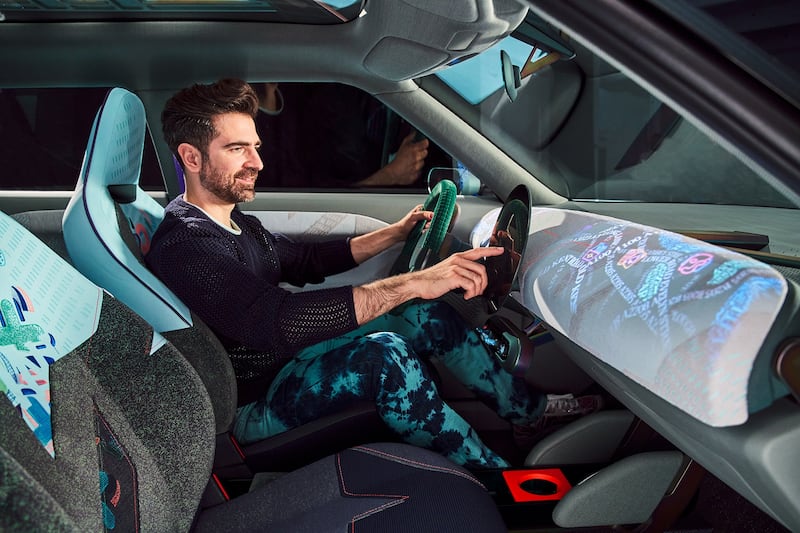Mini is gearing up fast for an all-electric future. The brand’s next-generation Countryman SUV, which will launch next year, will be the last new Mini model available with a combustion engine as it will come in petrol, electric, and plug-in hybrid forms.
It will also be bigger than the current car, stretching to 4.5m and so will be a rival to the likes of the Nissan Qashqai. That will leave a gap in the Mini range, because at the same time as the Countryman is getting bigger, the mid-sized and slow-selling Mini Clubman estate is going to be discontinued.
That gap will be filled by a second, compact, SUV model and that’s what you’re looking at here. Well, officially you’re looking at the Mini Aceman concept car, but it’s really a thinly-disguised version of the new car, which may well carry the Aceman name through to production (even if it’s uncomfortably close to the Paceman, the name of the utterly unlovely two-door coupe version of the first-generation Countryman SUV).
Mini says the Aceman has “a completely new design language and with advanced digitalisation, creating an intensive user experience”. In large part, that experience is about creating a car with a smaller environmental footprint. Aside from being entirely electric, the Aceman also eschews both leather and chrome, traditional markers of high-end cars but ones that come with a considerable carbon footprint and which also use chemically-intensive processes in their manufacture.
READ MORE

Instead, the cabin gets velvety soft-touch fabrics and textured “knitted” surfaces in place of leather while on the outside, traditional chrome trim has been banished in favour of cleaner, stripped-back styling that pushes the car’s aero-friendly flush-fit surfaces to the fore. Even the steering wheel’s multi-function buttons are touch-sensitive, backlit under a fabric skin.
The styling is actually much cleaner and more attractive than we’ve seen from Mini’s current production range. The existing line-up has tended towards too much fussy detailing, but the Aceman pares that back, for a cleaner, simpler shape which uses big, square, boxy wheel arches to underline its more rugged qualities. The grille is now no longer a grille, but a shape that’s lit around the edges by LEDs.
The cabin is pretty pared-back too. There’s a dinner plate sized-and-shaped screen in the centre of the dash, which apes the classic big speedometer of the original 1959 Morris Mini and Austin 7, and which at last banishes the square screen in round hole look of current Mini touchscreens. The screen gets a number of rather twee functions, including a radial “colour burst” of maximised pixels and a “Hello, Friend” message that lights up when you start the car. On a more serious note, the screen’s software has been designed by Google Android, which means seamless smartphone connectivity, while the screen itself has energy-efficient OLED technology.
Before you get in, there’s a light-up and sound sequence on the outside where the headlights track your approach to the car with a cloud of light that gets brighter as you approach, while the car plays a four-note tune (meant to represent the four letters of the Mini name) as you walk to the door. When the vehicle is unlocked, the matrix LED light units on the grille display a Union Jack graphic which may or may not go down well in some corners of this island, while the surround of the grille element lights up and the right headlamp gives a friendly wink.
The Aceman will be reasonably compact, measuring 4.05m in length which means it’s slightly shorter than a Nissan Juke, although Mini promises that the electric layout means it can still be spacious inside. “The purely electric vehicle concept makes it possible to steer the design more towards the traditional core values of Mini in line with the traditional principle of creative use of space,” says Oliver Heilmer, head of Mini design. “This creates models that take up little space on the road while offering even more comfort, more versatility and more emotion on the inside than ever before.”
It should still be practical, too. The concept Aceman comes with a built-in roof rack with fabric straps and the dashboard has large storage areas built into the top surface.
What kind of performance will the Aceman have? That is still being kept under wraps by Mini, but it should platform-share with the new Countryman which in turn shares a structure with the new BMW X1. In electric terms, the new iX1 gets a 76kWh battery and a one-charge range of 440km. The Aceman’s more compact dimensions mean it could potentially go further, but then it’s also likely to have a smaller battery, most likely a 60-ish kWh unit giving a range of about 400km.














